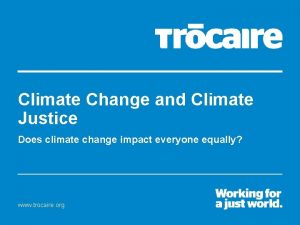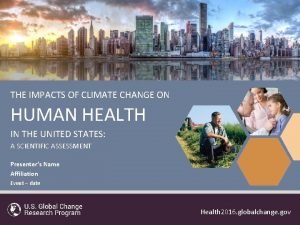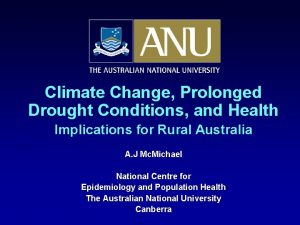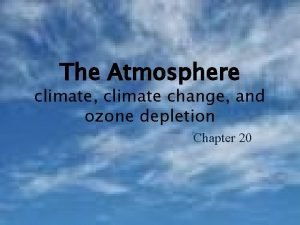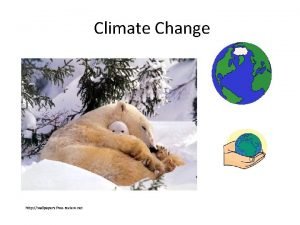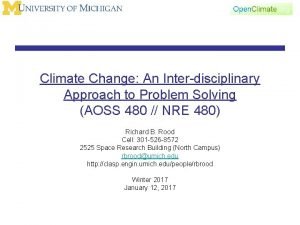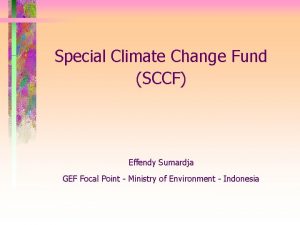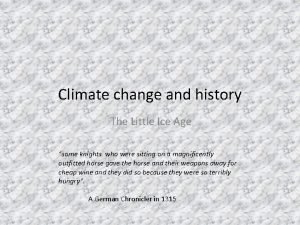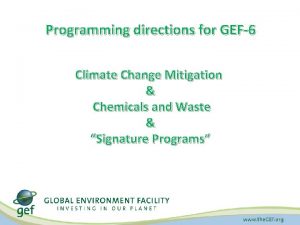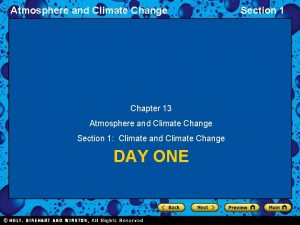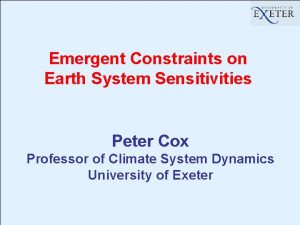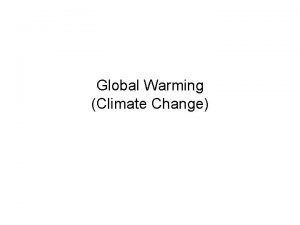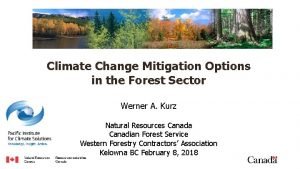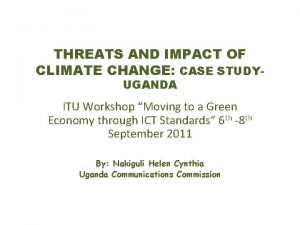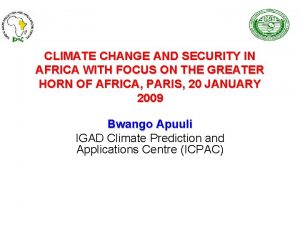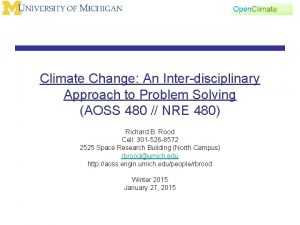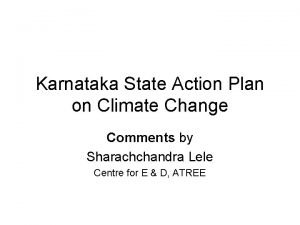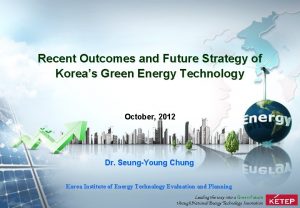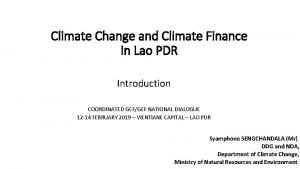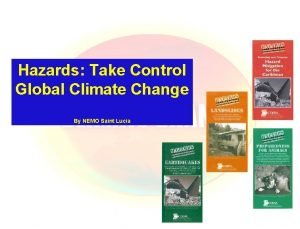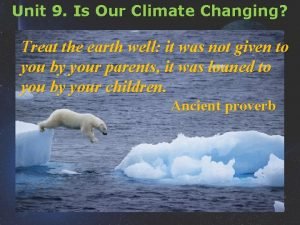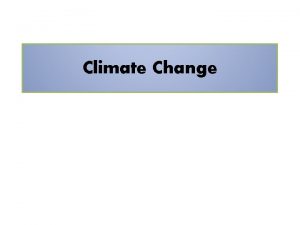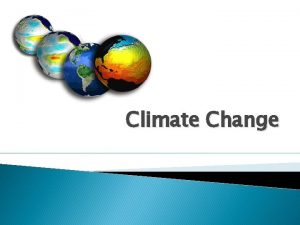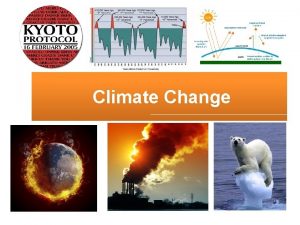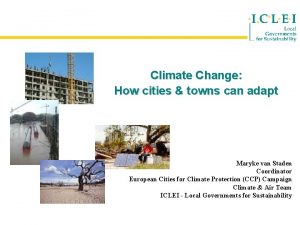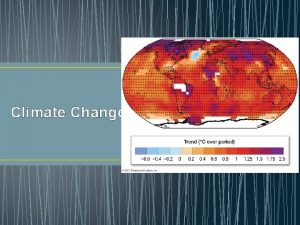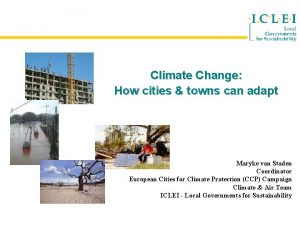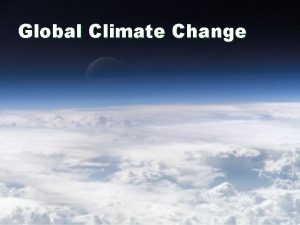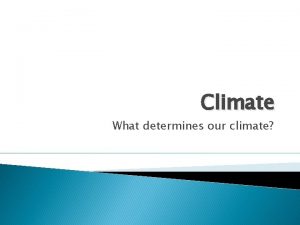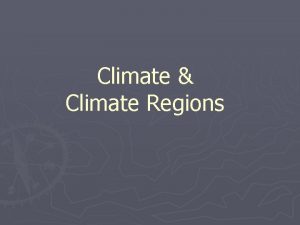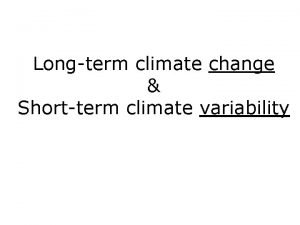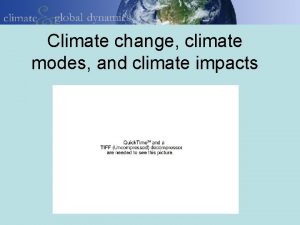What is climate change Climate change is a



































- Slides: 35

What is climate change? Climate change is a change in the statistical distribution of weather patterns when that change lasts for an extended period of time (i. e. , decades to millions of years). Climate change may refer to a change in average weather conditions. 3

Why Climate Changes There are both natural and anthropogenic reasons of climate change. • Anthropogenic activities the most dominant with an ever increasing trend since the industrial revolution of 1940 s. • Population growth in developing countries, which makes about 70% of the comity of nations, has been too high putting an increased pressure on fixed natural resources and the compensation of increased demand for food and shelter through better socio-economic conditions. • Temperature records of meteorological observatories (1500 -2900 masl) located in northern mountains of Pakistan from 1961 to 2010. Last decade has shown a sharp rise. (Source: PMD


NATURAL ACTIVITIES Natural Factors which influence Climate Change have remained constant for centuries. Since 1750, the average amount of energy coming from the sun either remained constant or increased slightly. If the warming were caused by a more active sun, then scientists would expect to see warmer temperatures in all layers of the atmosphere. Instead, they have observed a cooling in the upper atmosphere, and a warming at the surface and in the lower parts of the atmosphere. That's because greenhouse gasses are trapping heat in the lower atmosphere.


FACTS & EVIDENCES From 1880 to 2012, average global temperature increased by 0. 85°C. Oceans have warmed, the amounts of snow and ice have diminished and sea level has risen. From 1901 to 2010, the global average sea level rose by 19 cm as oceans expanded due to warming and ice melted. The Arctic’s sea ice extent has shrunk in every successive decade since 1979, with 1. 07 million km² of ice loss every decade. Global emissions of carbon dioxide (CO 2) have increased by almost 50 per cent since 1990 • � Given current concentrations and on-going emissions of greenhouse gases, it is likely that by the end of this century, the increase in global temperature will exceed 1. 5°C. The world’s oceans will warm and ice melt will continue. Average sea level rise is predicted as 24 – 30 cm by 2065 and 40 - 63 cm by 2100. Most aspects of climate change will persist for many centuries even if emissions are stopped. 2014 was the hottest year on record and 14 of the 15 warmest years on record have all occurred in the 21 st century.

IPCC In 1988, UNEP and WMO jointly established the Intergovernmental Panel on Climate Change (IPCC) as concern over climate change became a political issue. The purpose of the IPCC was to assess the state of knowledge on the various aspects of climate change including science, environmental and socio-economic impacts and response strategies. The IPCC is recognized as the most authoritative scientific and technical voice on climate change, and its assessments had a profound influence on the negotiators of the United Nations Framework Convention on Climate Change (UNFCCC) •

Climate Change in Pakistan For Pakistani’s, Climate Change is no longer a distant threat-we are already feeling and experiencing its impacts across the country and the region. Losses in the 2010 floods alone exceed US$ 9. 6 billion. Pakistan is signatory to all major UN climate change conferences Pakistan has an National Climate Change Policy. Pakistan is considered one of the top ten countries that are vulnerable to climate change.

Pakistan Climate Change and Vulnerability. As the rest of the world moves towards cleaner and renewable energy generation Pakistan is looking towards an energy generation future powered by coal. The developments of sources powered by renewable have been small in Pakistan‘s aim is to add 8, 100 megawatts of coal power to the system…. Pakistan’s contribution to global greenhouse gas (GHG) emissions is very small about 0. 08%. A new study released by WWF-Pakistan has found that agriculture here could face a loss of up to 10 pc of its output by 2040 due to climate change. � These Threats may lead Pakistan into concerns on its… • • Food Security Water Security Energy Security National Security

Climate Change Pakistan is the Third country which is most affected by climate change as per Global Climate Risk Index More rains in summer, and less rains in winter. Productivity of wheat and other winter crops is decreasing. Agriculture contributes 21% to the total GDP. Pakistan is an agrarian country, where 62% people depends on agriculture for their living.

Climate Change Pakistan Increased health risk and CC-induced migration Increased in disasters such as floods, heat wave etc. Loss in biodiversity Only 5. 2% land area is covered by forest (in 2010); it should be minimum of 20 -30%.

Climate Change Pakistan www. ifrc. org

Ministry of Climate Change Pakistan has elevated the climate change division to a ministry. The Ministry of Climate Change has been vested with the mandate to comprehensively address Disaster Management along with spearheading national climate change initiatives both in adaptation and mitigation. Attached Departments 1. 2. 3. 4. National Disaster Management Authority Pak EPA Zoological Survey Department (ZSD) Global Change Impact Study Center (GCISC)

1. 2. Climate change Policy of Pakistan 2012 The National Climate Change Policy provides a framework for addressing the issues that Pakistan faces or will face in future due to the changing climate. Policy Goal 1. To ensure Climate change is main-streamed into economically and socially vulnerable Sectors of the economy and to steer Pakistan towards Climate resilient development. 2. In view of Pakistan’s high vulnerability to the adverse impacts of climate change, in particular extreme events, adaptation effort is the focus of this policy document

Policy Objectives 3. 4. 5. 1. To pursue sustained economic growth by appropriately addressing the challenges of climate change; 2. To integrate climate change policy with other inter-related national policies; 3. To focus on pro-poor gender sensitive adaptation while also promoting mitigation to the extent possible in a cost- effective manner; 4. To ensure water security, food security and energy security of the country in the face of the challenges posed by climate change; 5. To minimize the risks arising from the expected increase in frequency and intensity of extreme weather events such as floods, droughts and tropical storms;

6. To facilitate effective use of the opportunities, particularly financial, available both nationally and internationally; 7. To foster the development of appropriate economic incentives to encourage public and private sector investment in adaptation measures; 8. To enhance the awareness, skill and stakeholders; institutional capacity of relevant 9. To promote conservation of natural resources and long term sustainability

CLIMATE CHANGE CENTRE (CCC) PESHAWAR • Khyber-Pakhtunkhwa (KP) is sheltering a population of more than 20 million people. The major portion of this population is dwelling in rural areas and depends on farming for their livelihoods. • Along with crop production and horticulture, livestock farming is also a dominant occupation of the rural communities particularly women. • Changes in temperatures and uncertain hydrological patterns are expected to affect food security and access to water in this highly diverse and ecologically fragile province. • Farmers are confronted with these changes and need to be supported in finding and developing adequate responses to these new challenges for ensuring their food security and resilience to weather extremes.

◦ ADAPTATION ◦ MITIGATATION

• Adaptation is usually distinguished from coping , which is conceptualised as a short term mechanism of dealing with immediate shocks • Coping begins when a household is forced tomobilize resources to respond to crises • Also responses to declining food availability and entitlements in abnormal seasons or years

• The degree to which adjustments are possible in practices or structures of systems to projected or actual changes of climate • This is largely influenced by system/community • (UNFCCC, 2002 and Reid & Vogel, 2006) resilience within the • It is also the ability of farmers to respond successfully and make adjustments to climate change

• Potential or the ability of a system region or communities to adapt to the effects or impacts of a stressor • Developed countries Vs Developing countries • Within countries (Low and High Favoured areas) • Within communities (The rich, the middle and the poor) • Gender, age, health etc (at family level)

Ø Human capital ◦ Knowledge on climate (scientific and local) ◦ Technical and political ◦ Education level/perceptions/health status Ø Information and technology ◦ Communication network (radio, TV, etc) ◦ Freedom of expression ◦ Technology transfer and packaging of information ◦ Innovative systems and capacity ◦ Early warning systems

◦ The goal of mitigation is to avoid significant human interference with the climate system. . . ◦ Switching to low-carbon energy sources such as wind power, solar, geothermal, hydroelectric or nuclear represents one of the major strategies for lowering the emissions of greenhouse gases in the atmosphere.

Climate Change: Cities & Rising Temperatures climate everyone’s business Climate change impacts are projected to raise global average surface temperature 2. 6– 4. 8 o. C by 2100. The world’s urban population is forecast almost to double by 2050. Climate change impacts on cities are increasing, and present threats to commerce, business and livelihoods. Global urban areas contain: More than half the world’s population Most built assets Most economic activities

Climate Change: Impacts on Weather Drought impacts include: Reduced arable land productivity Lower crops yields of wheat, rice, and maize Insecure freshwater availability Decreased hydropower electrical production Risks for power station cooling Increased water-related diseases Extreme weather events include: Flooding Heavy rainfall and strong winds Increased cyclones and storm surges climate everyone’s business

Climate Change: Risks to Urban Areas climate everyone’s business • Urban area risk levels for climate change • hazards will increase over the near-term. • By 2050, some urban areas will be exposed to a temperature rise of 2. 5 o. C, and in some cases over 4 o. C. • Key issues for cities include: Rising temperatures Heat stress Water security and pollution Sea-level rise and storm surges Extreme weather events Heavy rainfall and strong winds Inland flooding Food security

Climate Change: Implications for Cities climate everyone’s business Well-governed cities with universal provision of infrastructure and services provide a strong base for building climate resilience. Many rapidly developing cities lack the financial, technological, institutional and governance capacity required for effective mitigation. Impacts may worsen access to basic urban services and the quality of life. City sectors with mitigation potential: Buildings Energy Transport Industry Adaptation will become progressively more difficult for every degree of temperature rise.

Climate Change: Resilience (1/5) Resilience and adaptation options exist in areas such as: water, food, energy and transport. Water security: Strengthened, distributed, and autonomous water management and treatment Encouraging water recycling Use of greywater Improved storm and runoff management Developing new/alternative water sources Expanding storage facilities climate everyone’s business

Climate Change: Resilience (2/5) Food security: Support for urban and peri-urban agriculture Widespread green roofs, local markets, and social safety nets Improving the efficiency of urban markets Promoting farmers’ markets Investing in infrastructure and production technologies Supporting streetfood vendors Access to cheaper food Measures like cash transfers Develop alternative food sources Strengthen alternative foodstuffs distribution logistics climate everyone’s business

Climate Change: Resilience (3/5) Housing: Good quality, affordable, well-located housing to provide a strong base for city-wide climate change adaptation that minimises current exposure and loss. Rising temperatures: Green zones, wind corridors, green roofs, and water features – especially for schools, retirement facilities, and hospitals. Basic services: Establishing resilient systems for water supply, sanitation, storm water drains, electricity, transport, telecommunications, health care, education, and emergency response. climate everyone’s business

Climate Change: Resilience (4/5) Extreme weather and inland flooding: Distributed, resilient energy, healthcare, and command services Strengthening public transport infrastructure Stockpiling fuel, water, and food Improving building standards Improving wastewater, storm water and runoff infrastructure climate everyone’s business

Climate Change: Resilience (5/5) Planning: Local, national and international development policies can provide benefits at all scales. Funding adaptation: Local revenue raising policies (taxes, fees, charges) The use of local bond markets Public-private-partnership (PPP) contracts and concessions National or local financial markets National (or state/provincial) revenue transfers or incentive mechanisms Market-based investments climate everyone’s business

Climate Change: Mitigation Potential (1/1) climate everyone’s business The best plan for advancing sustainable urbanisation and low carbon development, especially in fast-growing parts of the world, requires political will and institutional capacity. Energy Supply Low-carbon technology: renewables, nuclear, or carbon capture and storage Switching from coal to gas as a bridging solution Transport Reducing emissions by avoiding journeys Shifting to low-carbon transport systems Enhancing vehicle and engine efficiency Substituting natural gas, biofuels, electricity, or hydrogen power for oil

Climate Change: Mitigation Potential (2/2) Urban form and infrastructure significantly affect GHG emissions. They are strongly linked to the use of materials and energy in a city, waste generated, and system efficiencies of a city. Low Carbon Cities Urban regeneration through compact, mixed-use development Promoting transit, walking, and cycling Adaptive reuse of buildings climate everyone’s business

 Climate change 2014 mitigation of climate change
Climate change 2014 mitigation of climate change Climate change causing droughts
Climate change causing droughts Climate change meaning
Climate change meaning Human causes of climate change
Human causes of climate change Climate change comic strip
Climate change comic strip Impacts of climate change
Impacts of climate change Causes of global warming
Causes of global warming Climate change sydney
Climate change sydney Youreuropemap.com
Youreuropemap.com Un climate change
Un climate change Financing education in a climate of change
Financing education in a climate of change Factors affecting climate change
Factors affecting climate change Global carbon project
Global carbon project Persuasive essay about global warming
Persuasive essay about global warming Special climate change fund (sccf)
Special climate change fund (sccf) Iceless cooler
Iceless cooler Climate change mitigation
Climate change mitigation How does climate change affect us
How does climate change affect us Chapter 13 atmosphere and climate change
Chapter 13 atmosphere and climate change Atmosphere
Atmosphere Conceptual framework maker
Conceptual framework maker Progressing emergent constraints on future climate change
Progressing emergent constraints on future climate change Outline of climate change
Outline of climate change Climate change activities
Climate change activities Global warming pathos
Global warming pathos Conclusion of climate change
Conclusion of climate change Rhetorical questions about climate change
Rhetorical questions about climate change Conclusion of climate change
Conclusion of climate change Interdisciplinary approach to climate change
Interdisciplinary approach to climate change Karnataka state action plan on climate change
Karnataka state action plan on climate change Strategy and future
Strategy and future Climate change activities
Climate change activities References of climate change
References of climate change Climate change national security threat
Climate change national security threat Pc 414
Pc 414 Unit 9 climate change
Unit 9 climate change

